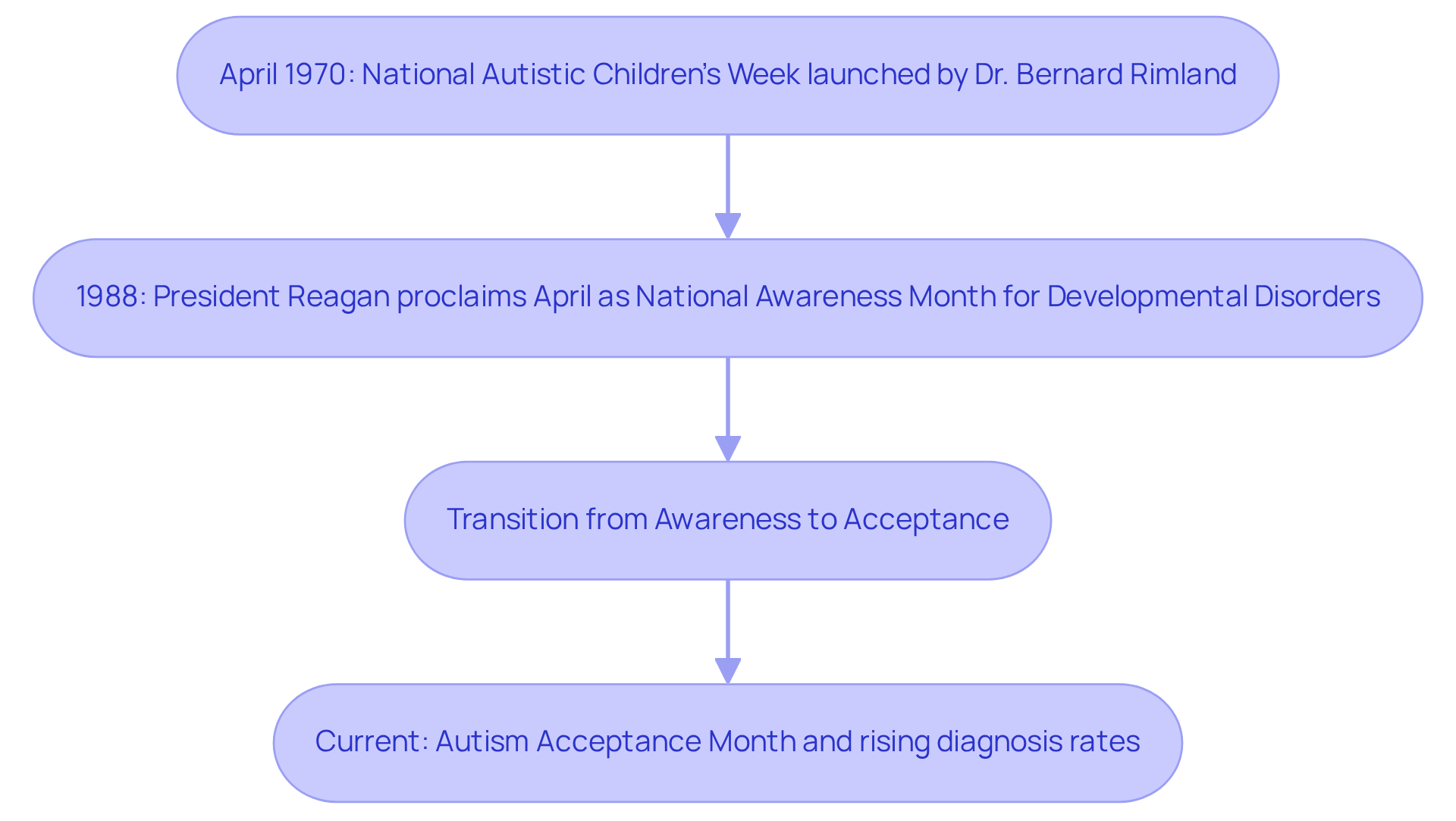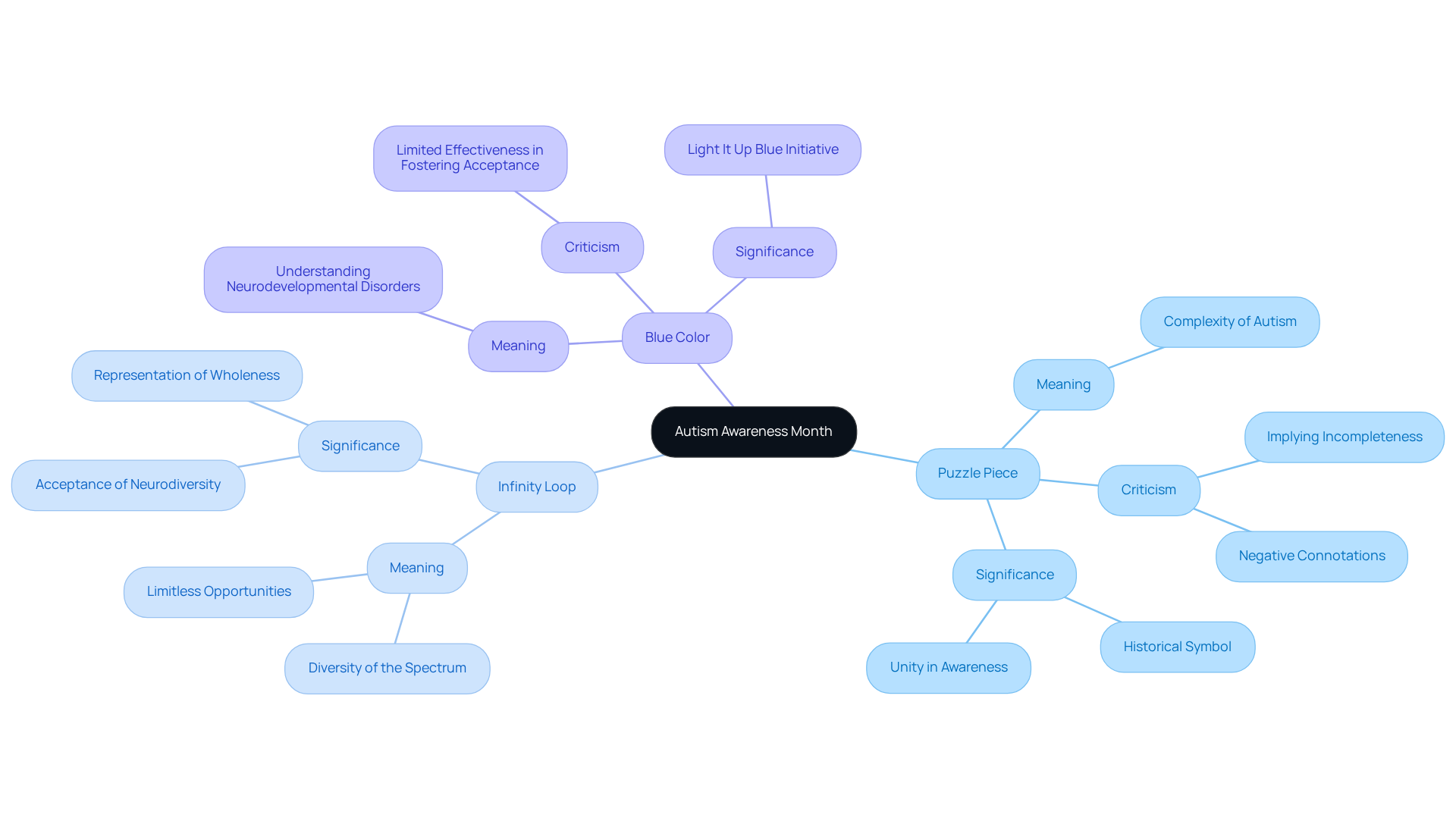Overview
April marks Autism Awareness Month, a time dedicated to deepening our understanding and acceptance of Autism Spectrum Disorder within our communities. This observance is significant, as it highlights key historical milestones and shares current statistics on autism prevalence. By emphasizing the importance of advocacy and community engagement, we can work together to create a supportive environment for individuals on the spectrum.
As we reflect on these milestones, it's essential to recognize the challenges faced by families and individuals living with autism. Many parents share stories of navigating a world that often feels unwelcoming, yet their resilience shines through. By listening to these experiences, we can foster a greater sense of empathy and understanding.
Let's come together to support one another during this important month. Whether through sharing resources, participating in local events, or simply engaging in conversations, each action contributes to a more inclusive society. Your involvement matters, and together, we can make a difference.
Introduction
April marks a pivotal time for raising awareness and understanding of Autism Spectrum Disorder, a condition that now affects 1 in 36 children in the U.S. This month is not just about statistics; it’s a heartfelt call for communities to come together in promoting acceptance and inclusion. As we engage in advocacy and education, we must reflect on a crucial question: how can we transform awareness into genuine acceptance?
It’s essential to foster an environment where individuals on the spectrum are not only understood but celebrated for their unique contributions. Together, let’s explore how we can make this a reality.
Define Autism Awareness Month: Significance and Purpose
April is what month is autism awareness, a time dedicated to enhancing understanding and knowledge of Autism Spectrum Disorder. This month, which is known as what month is autism awareness, emphasizes the importance of acceptance and inclusion for individuals on the autism spectrum within our communities. It serves as a crucial platform for advocacy, education, and community engagement, inviting everyone to partake in activities that raise awareness.
In 2025, the significance of Awareness Month is underscored by a CDC report indicating that this condition now affects 1 in 36 children in the U.S. This statistic highlights the urgent need for increased understanding and support. Throughout what month is autism awareness, various events, campaigns, and initiatives aim to inform the public about the condition, its challenges, and the strengths of those affected.
For instance, effective initiatives during Autism Recognition Month have led to greater community involvement and understanding, showcasing the positive impact of educational efforts. As supporters often remind us, "Increasing understanding about developmental disorders is essential for early detection and action." This emphasizes the importance of this month in creating a nurturing atmosphere where individuals with developmental disorders can thrive.
It is also vital to recognize that 28% of children with developmental disorders exhibit self-injurious behaviors, underscoring the pressing need for awareness and intervention during this month. Additionally, 70% of qualified autistic individuals in the U.S. receive vocational rehabilitation (VR) services, demonstrating successful initiatives that promote understanding and inclusion, particularly in employment support for autistic individuals. Notably, nearly 60% of individuals with developmental disorders in the U.S. find employment after obtaining VR services, highlighting the positive outcomes of community support and engagement.
Ultimately, Awareness Month is not just about raising understanding; it is about cultivating a community that cherishes diversity and empowers individuals with developmental differences to reach their full potential.

Trace the Origins of Autism Awareness Month: Historical Development
The origins of what month is autism awareness can be traced back to April 1970, when Dr. Bernard Rimland, a dedicated psychologist and advocate for individuals with developmental disorders, launched the first National Autistic Children's Week. This important initiative was designed to foster understanding and acceptance of autism. Fast forward to 1988, when President Ronald Reagan proclaimed April as National Awareness Month for Developmental Disorders, which brings to mind the question of what month is autism awareness.
Over the years, this observance has transformed, shifting its focus from merely raising awareness to actively promoting acceptance and inclusion. In recent times, we have seen the emergence of Autism Acceptance Month, raising awareness about what month is autism awareness and reflecting a deeper understanding of the needs and rights of individuals with developmental disorders. Currently, it's estimated that 1 in 31 children are diagnosed with this condition, with rates increasing by 10-17% each year.
This historical journey highlights the ongoing efforts toward greater awareness and support for the neurodiverse community. As U.S. Health and Human Services Secretary Robert F. Kennedy, Jr. noted, the epidemic of developmental disorders is unprecedented, emphasizing the urgent need for continued advocacy and assistance for individuals on the spectrum. Together, we can create a more inclusive world where every individual is understood and valued.

Identify Key Symbols and Characteristics of Autism Awareness Month
Awareness Month is marked by several key symbols, each representing different facets of the community connected to this condition. One of the most recognized symbols, the puzzle piece, was introduced in 1963. It signifies the complexity of the condition and the ongoing quest for understanding. However, it has faced criticism for implying that individuals with developmental disorders are incomplete.
In contrast, the infinity loop, often depicted in vibrant rainbow hues, symbolizes the diversity of the spectrum and the limitless opportunities available to those on the autism spectrum. This shift toward the infinity symbol reflects a growing acceptance of neurodiversity, highlighting that autistic individuals are whole and valued members of society.
Additionally, the color blue is commonly associated with the understanding of neurodevelopmental disorders, particularly during the 'Light It Up Blue' initiative launched by Autism Speaks. Although this campaign has raised awareness, its effectiveness in fostering genuine understanding has been questioned, with some studies suggesting that recognition does not always lead to acceptance.
These symbols serve not only as visual representations but also as rallying points for advocacy, nurturing a sense of community and shared purpose among individuals, families, and supporters of those with developmental disorders. The transition from awareness to acceptance is vital in today's advocacy landscape, as it encourages a more inclusive understanding of autism.

Conclusion
April is a vital month dedicated to fostering understanding and acceptance of Autism Spectrum Disorder. It invites communities to unite in promoting awareness and inclusion, recognizing the importance of supporting individuals on the spectrum. This month is not only about acknowledging the challenges faced by those with autism but also about celebrating their unique contributions and potential within society.
Throughout this article, we have explored key points, including:
- The historical origins of Autism Awareness Month
- Critical statistics highlighting the prevalence of autism
- The significance of advocacy and education in creating supportive environments
The transition from awareness to acceptance is emphasized as essential for nurturing a community that values neurodiversity. Symbols such as the infinity loop and the color blue play significant roles in representing the complexities and diversity of the autism spectrum, reinforcing the message that every individual is whole and deserving of respect.
Ultimately, the significance of Autism Awareness Month extends beyond awareness; it calls for collective action to create a more inclusive world. By engaging in educational initiatives and community support, each of us can contribute to a culture that cherishes diversity and empowers individuals with developmental differences. Embracing this mission not only benefits those on the autism spectrum but enriches society as a whole, fostering understanding and compassion for all.
Frequently Asked Questions
What is Autism Awareness Month?
Autism Awareness Month is a dedicated time in April aimed at enhancing understanding and knowledge of Autism Spectrum Disorder. It emphasizes the importance of acceptance and inclusion for individuals on the autism spectrum within our communities.
Why is Autism Awareness Month significant?
The significance of Autism Awareness Month is highlighted by the increasing prevalence of autism, with a CDC report indicating that 1 in 36 children in the U.S. are affected. This underscores the urgent need for increased understanding and support for individuals with autism.
What activities take place during Autism Awareness Month?
Various events, campaigns, and initiatives occur throughout Autism Awareness Month to inform the public about autism, its challenges, and the strengths of those affected. These activities aim to raise awareness and encourage community engagement.
How do initiatives during Autism Awareness Month impact the community?
Effective initiatives during Autism Awareness Month have led to greater community involvement and understanding, showcasing the positive impact of educational efforts on awareness and acceptance of individuals with developmental disorders.
What statistics highlight the need for awareness and intervention during Autism Awareness Month?
It is noted that 28% of children with developmental disorders exhibit self-injurious behaviors, emphasizing the pressing need for awareness and intervention. Additionally, 70% of qualified autistic individuals in the U.S. receive vocational rehabilitation (VR) services, which support their inclusion in the workforce.
What are the employment outcomes for individuals with developmental disorders who receive VR services?
Nearly 60% of individuals with developmental disorders in the U.S. find employment after obtaining VR services, highlighting the positive outcomes of community support and engagement.
What is the overall goal of Autism Awareness Month?
The overall goal of Autism Awareness Month is to raise understanding and cultivate a community that cherishes diversity, empowering individuals with developmental differences to reach their full potential.




